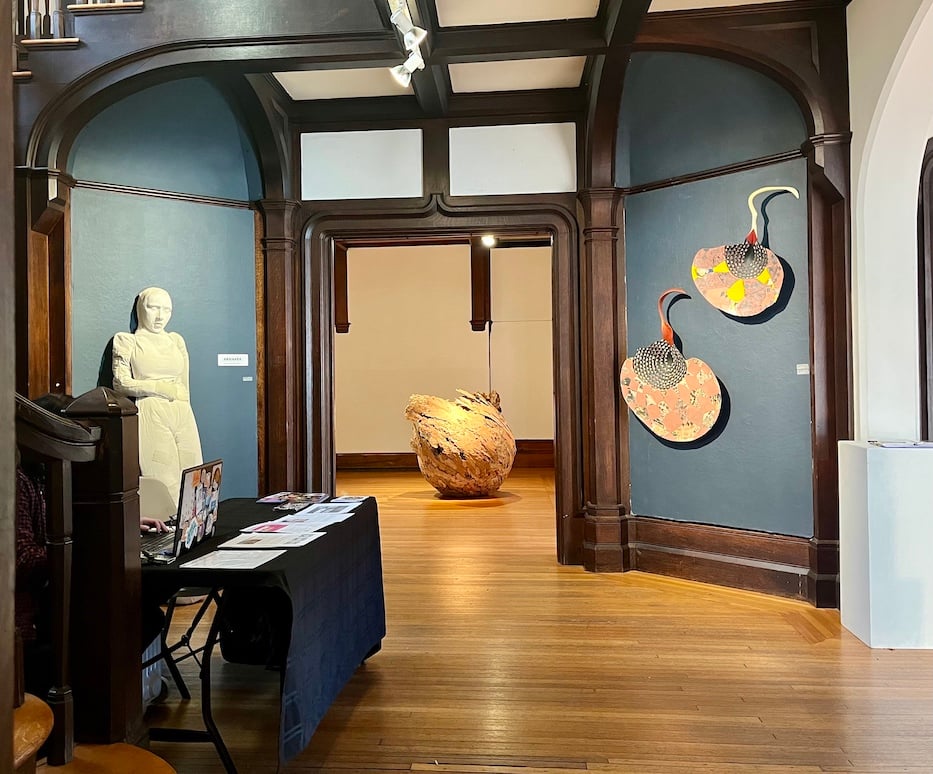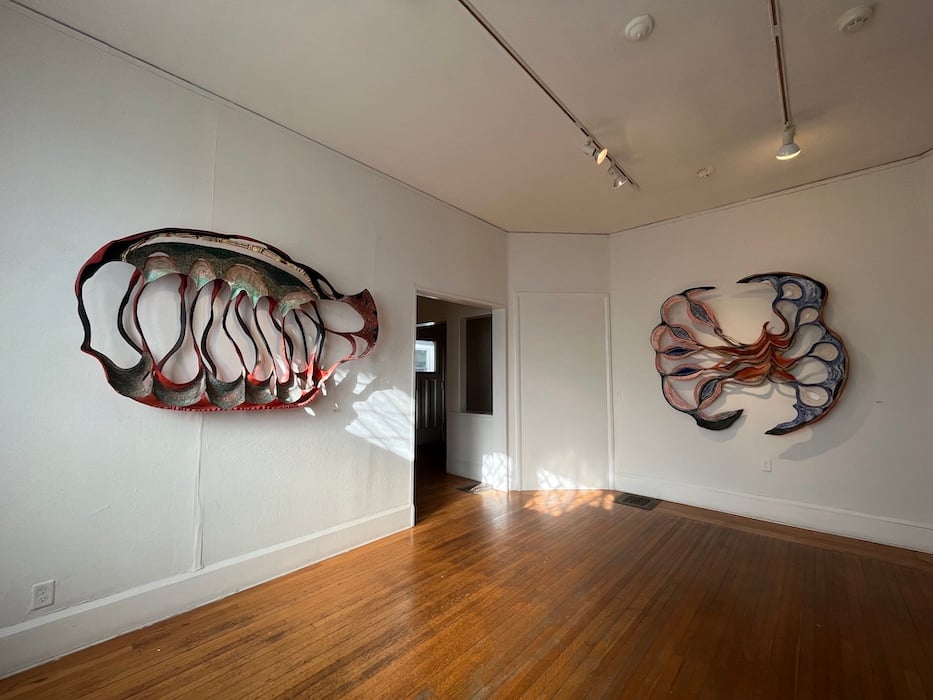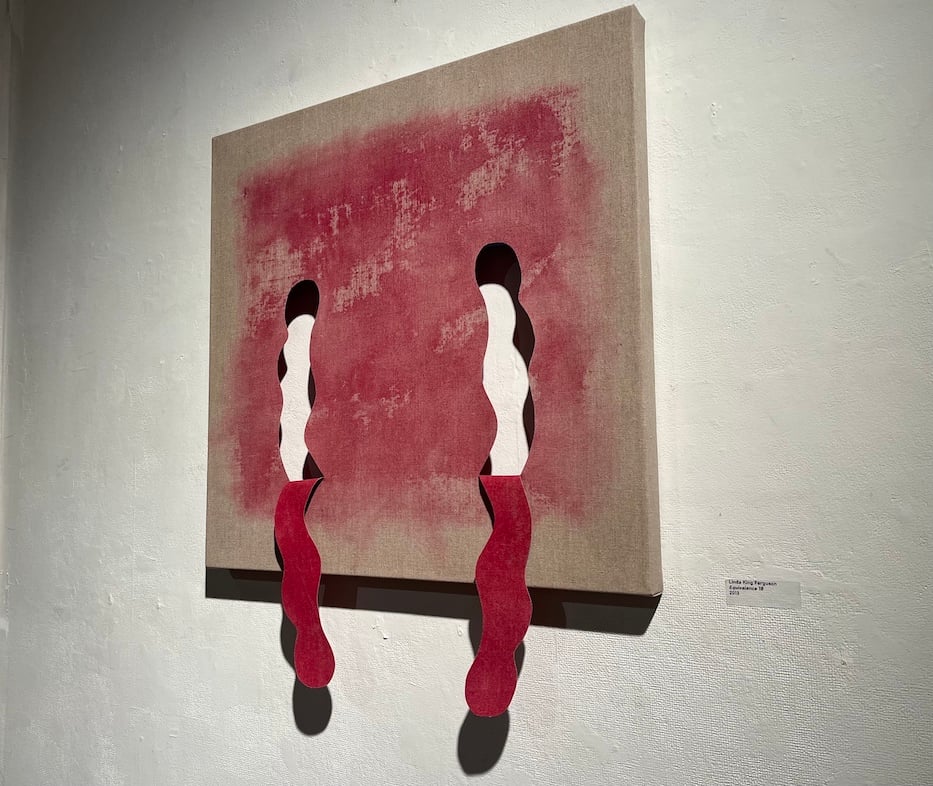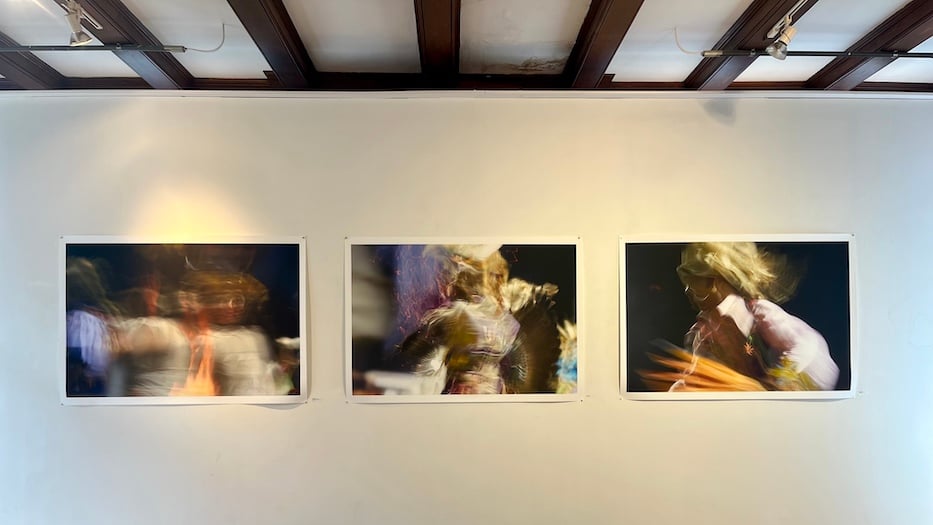%3B%20Greg%20Slick_The%20Lives%20of%20Others%207%20and%20The%20Lives%20of%20Others%2017%3B%20Donna%20Forma_Freeing%20The%20Mind.jpg?width=933&height=700&name=Steven%20DiGiovanni_Untitled%20(chasm)%3B%20Greg%20Slick_The%20Lives%20of%20Others%207%20and%20The%20Lives%20of%20Others%2017%3B%20Donna%20Forma_Freeing%20The%20Mind.jpg)
Steven DiGiovanni, Untitled (chasm); Greg Slick The Lives of Others 7 and The Lives of Others 17; Donna Forma, Freeing The Mind. Miranda Jeyaretnam Photos.
The natural world is stirring to life inside the Ely Center of Contemporary Art.
A giant sphere made of layers of paper sits in the middle of one room, facing a painting of a reimagined industrial Eden. Other rooms hold amoeba-esque wood carvings, reminiscent of the dots in aboriginal art or fish scales. A vine-like structure climbs to the ceiling, composed of bits of detritus at its root. It creates a kind of inverted reflection of the trees peering through the window facing it.
These artworks are part of Primal Affinities I, which runs now through January 5, 2023 at the Ely Center of Contemporary Art at 51 Trumbull St. Curated by Debbie Hesse and Maxim Scmidt, the exhibition features artists Steven DiGiovanni, Linda King Ferguson, Donna Forma, Becca Lowry, Greg Slick, and Kim Weston.
Running parallel to Primal Affinities at the Perspectives Gallery at the Whitney Center in Hamden and Akwaaba at the Ely Center, Primal Affinities I speaks to the essence of nature and its interaction with humans.
.jpg?width=933&height=700&name=Donna%20Forma_Layers%20(2).jpg)

Top: Detail, Donna Forma's Layers. bottom: Donna Forma's Layers; Becca Lowry's Don't Forget the Flowers and Too Much World. Miranda Jeyaretnam Photos.
“[It’s about] this idea of being so elemental and primal that there are certain universal connections and things,” Hesse said. “Whether it's the unfolding of natural materials or suggested movement patterns from nature and culture.”
A viewer can see that throughout the show. In the center of one wood-paneled room sits Layers, a walnut or seed-like structure made of handmade paper of light and brown shades. At over three feet on each side, the sculpture by Donna Forma relays a sense of the natural, the guttural, and the primal.
Freeing the Mind, one of Forma’s other works, is a cloud-like structure made of thread, dog fur, handmade paper, and sticks, mounted on a wall on one of the second-floor rooms. Like Layers, the floating fabric construction seems to travel through time, conveying the effects of weather, age, and evolution. It’s a feat for a man-made art piece that pulls together materials not commonly associated with each other.

Lowry’s work in the Ely Center. Miranda Jeyaretnam Photos.
Becca Lowry’s works—large-scale, wall-mounted wood carvings—appear both like living biological forms and fossils. The cross-links and weaving of thread across the wood render the carvings gill or vessel-like. The Santa Anas, whose title references the Santa Ana canyon of Orange County, as well as the Santa Ana winds that rush through the canyon, sweep across deserts, and push dust over the Pacific Ocean, looks like a marine life form, with its bright blues and oranges appearing like fish scales.
Lowry’s pieces act as “metaphors” for body parts and plant life, Hesse said. They play with macro and micro scales, from its detailed weaving to its enlarged structures.
Nearby, Linda King Ferguson’s deconstructed canvasses jump off the wall. Taking the linen canvas—typically reserved for traditional forms of art like painting—and carefully cutting out shapes, Equivalence 18 looks almost like it is crying, but the red acrylic stain rubbed across it creates the sense of bleeding. Equivalence 86, a red square canvas with zigzagged strips cut across it, conveys a similar sense of a wounded body.

 Top: Linda King Ferguson's Equivalence 18. Bottom: Kim Weston's A Cry For My Missing Sisters; Firewalker; Pink Flowers, Orange Rhythms. Miranda Jeyaretnam Photos.
Top: Linda King Ferguson's Equivalence 18. Bottom: Kim Weston's A Cry For My Missing Sisters; Firewalker; Pink Flowers, Orange Rhythms. Miranda Jeyaretnam Photos.
A momentum runs through the show. Kim Weston’s dynamic photographs meet you at the top of the stairs, on the second floor gallery. Despite her use of a two-dimensional medium, her works saturate the room they hang in. The photographs, which are of Native American dancers from various tribes at pow wows across the East Coast, explode with color and movement. In many of them, you can make out the face or the body of a dancer, but the hard outlines are softened and blended together by the incredible motion blur. Instead, the subject of the photographs became the rhythm and movement of the dance itself.
The interaction between the artworks and the space of the Ely Center adds to the elemental sense of the exhibition. Described by Hesse as a “local global space,” the many rooms and levels to the mansion create unexpected relationships between the pieces. Light streaming into the first room of the gallery is filtered through the stained glass windows, painted using children’s craft materials by Jonathan Weinberg as part of another exhibition, called Genesis. The play of light and color creates an airiness that makes Forma’s floor sculpture only more impressive.
.jpg?width=933&height=700&name=Donna%20Forma_Freeing%20The%20Mind%20(3).jpg)
Donna Forma, Freeing The Mind. Miranda Jeyaretnam Photos.
Hesse described how different artworks by the same artists appeared at the Whitney Center, a not-for-profit retirement community in Hamden. The Perspectives Gallery, a long uninterrupted space, is like a “run on sentence,” Hesse said, so works had to be curated to work together very differently. At the Ely Center, Hesse and Schmidt had more freedom to innovate and take risks, with the building’s different rooms allowing them to create “little vignettes and mini conversations” between the works.
“Every angle, you look here, and you see a new relationship between works that you can't plan for no matter how long you've curated in the space,” Hesse said. “There's just things that the space, it speaks to you.”
Schmidt recalled having to throw his whole body weight against Layers in order to haul it into the gallery — an experience that adds to the bodily sense of the whole exhibition. “One of the challenges and also treats of getting to be here is all of our exhibits are site specific with heavy woodwork,” Schmidt said. “We have to curate each space very carefully while trying to create that common thread throughout the building.”
“It's a gift,” Hesse said. “It's just a pure total gift.”
The Ely Center of Contemporary Art is located at 51 Trumbull St. in New Haven. For hours and more information, check their website.